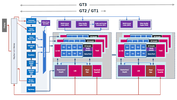NVIDIA GeForce GTX 660 Ti vs Intel Iris Pro Graphics P580 vs Intel HD Graphics 510
NVIDIA GeForce GTX 660 Ti
► remove from comparison
Die NVIDIA GeForce GTX 660 Ti ist eine DirectX-11.1-fähige High-End-Grafikkarte für Desktop-PCs. Sie basiert auf dem im 28-nm-Prozess hergestellten GK104-Chip der Kepler-Architektur. Im Vergleich zur GTX 680 enthält die GTX 660 Ti knapp 13 % weniger Shader-Einheiten (1.344 statt 1.536 CUDA-Cores). Der Kerntakt variiert unter Last zwischen 915 und 980 MHz (GTX 680: 1.006-1.058 MHz). Der Speichertakt des 2.048 MByte großen GDDR5-VRAMs ist wie bei der GTX 680 üppige 1.500 MHz (3.000 MHz I/O, 6.000 MHz effektiv) hoch. Das Interface hat Nvidia von 256 auf 192 Bit verkleinert.
Architektur
Kepler ist der Nachfolger der beliebten Fermi-Architektur, welche unter anderem bei der GeForce-500-Reihe zum Einsatz kam. Der zugrunde liegende GK104-Chip verfügt über sieben SMX-Blöcke mit je 192 CUDA-Cores. Zwei SMX bilden zusammen mit zwei Polymorph-Engines und einer gemeinsamen Raster-Engine einen sogenannten GPC (Graphics Processing Cluster). Da die Shader keine eigene Takt-Domain mehr besitzen (Hot Clock), entspricht die Rechenleistung in etwa der Hälfte der Einheiten der Fermi-Architektur mit doppelter Taktrate. Diese Änderung ist einer der Gründe dafür, dass sich laut Nvidia die Energieeffizienz gegenüber dem Vorgänger verdoppelt hat. Auch die Tessellation-Leistung soll verbessert worden sein.
Als weitere Neuerungen werden PCIe 3.0, der Turbo-Modus GPU Boost und das Kantenglättungsverfahren TXAA genannt. Adaptives VSync soll bei hohen Bildwiederholraten störendes Tearing verhindern.
Leistung
Die Performance der GeForce GTX 660 Ti liegt - trotz der niedrigeren Produktnummer - teils spürbar über der mobilen GTX 680M, wobei sich der Vorsprung manchmal in Grenzen hält. Jedes aktuelle Spiel (Stand 2013) läuft auch in maximalen Einstellungen flüssig. Für hohe Auflösungen im Bereich von 1.920 x 1.080 hat die GPU meist genug Power. Selbiges gilt für mehrfache Kantenglättung.
Features
Das aktualisierte Featureset umfasst nun die Unterstützung von bis zu vier aktiven Displays, die beispielsweise per DisplayPort 1.2 oder HDMI 1.4a mit Bildmaterial versorgt werden. HD-Audio-Formate wie Dolby True HD und DTS-HD lassen sich als Bitstream an einen geeigneten Receiver übertragen.
Der HD-Videoprozessor der fünften Generation (VP5) wurde vom GF119-Chip übernommen. Dieser kann die Formate MPEG-1, MPEG-2, MPEG-4, H.264 und VC1/WMV9 bis zu einer Auflösung von 4k decodieren und somit den Prozessor entlasten. Auch zwei parallele Streams, zum Beispiel für Picture-in-Picture bei Blu-Rays, sind möglich. Eine weitere Neuerung ist die Integration eines dedizierten Videoencoders ähnlich Intels Quick Sync, der über die NVENC-API angesprochen werden kann.
Als TDP gibt Nvidia 150 Watt an. Die Standard-Variante benötigt zwei 6-Pin-Stromstecker.
Hinweis
Für unsere Benchmarks verwenden wir eine leicht übertaktete Version, deren Kern mit 980-1059 statt 915-980 MHz arbeitet. Die Speichergröße (3072 vs. 2048 MByte) weicht ebenfalls vom Referenz-Design ab.
Intel Iris Pro Graphics P580
► remove from comparisonDie Intel Iris Pro Graphics P580 (GT4e) ist eine Prozessorgrafikkarte der im Sommer 2015 vorgestellten Skylake-Generation. Als Nachfolger der Iris Pro Graphics 6200 (Broadwell) ist die Iris Pro P580 dabei in ausgewählten Quad-Core-Modellen der Xeon-Serie zu finden und besitzt einen dedizierten eDRAM-Cache mit 128 MB Kapazität. Die sogenannte GT4e-Ausbaustufe der Skylake-GPU verfügt zudem über 72 Execution Units (EUs) und damit deutlich mehr Rechenleistung als die GT2- (24 EUs) und GT3e-Ausbaustufen (48 EUs). Neben dem eDRAM-Cache kann die Iris P580 auch über das Interface des Prozessors auf den Hauptspeicher zugreifen (2x 64 Bit DDR3L-1600/DDR4-2133).
Im Unterschied zur Consumer-Variante Iris Pro Graphics 580 ist die Iris P580 ausschließlich den professionellen Xeon-Modellen vorbehalten, weist ansonsten aber keine bedeutsamen technischen Abweichungen auf.
Performance
Die exakte Leistung der Iris Pro Graphics P580 ist bislang noch nicht bekannt und hängt unter anderem vom jeweiligen CPU-Modell sowie der Speicherbestückung ab. Im Optimalfall sollte die Performance aber knapp an eine dedizierte GeForce 945M heranreichen und liegt damit in der Mittelklasse mobiler Grafikchips des Jahres 2015/2016. Aktuelle Spiele können zumeist in mittleren Einstellungen flüssig dargestellt werden.
Features
Die überarbeitete Videoeinheit decodiert nun auch H.265-/HEVC-Videos vollständig in Hardware und arbeitet dadurch deutlich effizienter als bislang. Die Bildausgabe erfolgt über DP 1.2/eDP 1.3 (max. 3.840 x 2.160 @ 60 Hz), wohingegen HDMI nur in der älteren Version 1.4 angeboten wird. Ein HDMI-2.0-Anschluss kann aber mittels Konverter von DisplayPort ergänzt werden. Maximal lassen sich drei Displays parallel angesteuern.
Leistungsaufnahme
Die Iris Pro Graphics P580 wird zunächst ausschließlich in Prozessoren der 45-Watt-Klasse verbaut und ist damit vorrangig in größeren Notebooks zu finden.
Intel HD Graphics 510
► remove from comparison
Die Intel HD Graphics 510 (GT1) ist eine Prozessorgrafikkarte der im September 2015 vorgestellten Skylake-Generation (z.B. Pentium 4405U). Zwar glänzt die GPU mit einer niedrigen Leistungsaufnahme, allerdings siedelt sich die Performance nur im Low-End-Segment an und ist für neuere Spiele selten ausreichend. Als sogenannte GT1-Ausbaustufe der Skylake-GPU verfügt die HD Graphics 510 über 12 Execution Units (EUs), die je nach Modell mit bis zu 950 MHz takten.
Mangels eigenem Grafikspeicher oder eDRAM-Cache greift die HD Graphics 510 über das Interface des Prozessors auf den System-RAM zu (2x 64 Bit DDR3L-1600/LPDDR3-1866).
Performance
Die exakte Leistung der HD Graphics 510 dürfte sich knapp unterhalb der älteren HD Graphics 4400 ansiedeln, sodass aktuelle Spiele (Stand 2015) nur in wenigen Fällen und in niedrigsten Einstellungen flüssig dargestellt werden.
Features
Der überarbeitete Videodecoder decodiert nun auch H.265-/HEVC-Videos vollständig in Hardware und arbeitet dadurch deutlich effizienter als bislang. Die Bildausgabe erfolgt über DP 1.2/eDP 1.3 (max. 3.840 x 2.160 @ 60 Hz), wohingegen HDMI nur in der älteren Version 1.4a angeboten wird. Ein HDMI-2.0-Anschluss kann aber mittels Konverter von DisplayPort ergänzt werden. Maximal lassen sich drei Displays parallel angesteuern.
Leistungsaufnahme
Die TDP des gesamten Chips liegt standardmäßig bei 15 Watt, sodass die GPU vor allem in Ultrabooks oder oder schlanken Notebooks zu finden ist. Teils kann die TDP auch auf 10 Watt abgesenkt werden, wodurch allerdings die Performance sinkt.
| NVIDIA GeForce GTX 660 Ti | Intel Iris Pro Graphics P580 | Intel HD Graphics 510 | |||||||||||||||||||||||||||||||||||||||||||||||||||||||||||||||||||||||||||||||||||||||||||
| Gen. 9 Serie |
|
|
| ||||||||||||||||||||||||||||||||||||||||||||||||||||||||||||||||||||||||||||||||||||||||||
| Codename | GK104 | Skylake GT4e | Skylake GT1 | ||||||||||||||||||||||||||||||||||||||||||||||||||||||||||||||||||||||||||||||||||||||||||
| Architektur | Kepler | Gen. 9 Skylake | Gen. 9 Skylake | ||||||||||||||||||||||||||||||||||||||||||||||||||||||||||||||||||||||||||||||||||||||||||
| Pipelines | 1344 - unified | 72 - unified | 12 - unified | ||||||||||||||||||||||||||||||||||||||||||||||||||||||||||||||||||||||||||||||||||||||||||
| Kerntakt | 915 - 980 (Boost) MHz | 350 - 1100 (Boost) MHz | 300 - 950 (Boost) MHz | ||||||||||||||||||||||||||||||||||||||||||||||||||||||||||||||||||||||||||||||||||||||||||
| Speichertakt | 6000 MHz | ||||||||||||||||||||||||||||||||||||||||||||||||||||||||||||||||||||||||||||||||||||||||||||
| Speicherbandbreite | 192 Bit | eDRAM + 64/128 Bit | 64/128 Bit | ||||||||||||||||||||||||||||||||||||||||||||||||||||||||||||||||||||||||||||||||||||||||||
| Speichertyp | GDDR5 | eDRAM | DDR3/DDR4 | ||||||||||||||||||||||||||||||||||||||||||||||||||||||||||||||||||||||||||||||||||||||||||
| Max. Speichergröße | 3 GB | 128 MB | |||||||||||||||||||||||||||||||||||||||||||||||||||||||||||||||||||||||||||||||||||||||||||
| Shared Memory | nein | ja | ja | ||||||||||||||||||||||||||||||||||||||||||||||||||||||||||||||||||||||||||||||||||||||||||
| API | DirectX 11, Shader 5.1 | DirectX 12_1, OpenGL 4.4 | DirectX 12_1, OpenGL 4.4 | ||||||||||||||||||||||||||||||||||||||||||||||||||||||||||||||||||||||||||||||||||||||||||
| Stromverbrauch | 150 Watt | ||||||||||||||||||||||||||||||||||||||||||||||||||||||||||||||||||||||||||||||||||||||||||||
| Transistors | 3.5 Billion | ||||||||||||||||||||||||||||||||||||||||||||||||||||||||||||||||||||||||||||||||||||||||||||
| Herstellungsprozess | 28 nm | 14 nm | 14 nm | ||||||||||||||||||||||||||||||||||||||||||||||||||||||||||||||||||||||||||||||||||||||||||
| Features | SLI, PhysX, CUDA, 3D Vision , GPU Boost | QuickSync | QuickSync | ||||||||||||||||||||||||||||||||||||||||||||||||||||||||||||||||||||||||||||||||||||||||||
| Erscheinungsdatum | 16.08.2012 | 24.01.2016 | 01.09.2015 | ||||||||||||||||||||||||||||||||||||||||||||||||||||||||||||||||||||||||||||||||||||||||||
| Herstellerseite | www.nvidia.de |
|
| |||||||||||||||||||||||||
Benchmarks
3DM Vant. Perf. total + NVIDIA GeForce GTX 660 Ti
Cinebench R15 OpenGL 64 Bit + Intel HD Graphics 510
GFXBench T-Rex HD Offscreen C24Z16 + Intel HD Graphics 510
Average Benchmarks NVIDIA GeForce GTX 660 Ti → 0% n=0
Average Benchmarks Intel HD Graphics 510 → 0% n=0
* Smaller numbers mean a higher performance
1 This benchmark is not used for the average calculation
Spiele-Benchmarks
Die folgenden Benchmarks basieren auf unseren Spieletests mit Testnotebooks. Die Performance dieser Grafikkarte bei den gelisteten Spielen ist abhängig von der verwendeten CPU, Speicherausstattung, Treiber und auch Betriebssystem. Dadurch müssen die untenstehenden Werte nicht repräsentativ sein. Detaillierte Informationen über das verwendete System sehen Sie nach einem Klick auf den fps-Wert.

Resident Evil 7
2017
Titanfall 2
2016
Farming Simulator 17
2016
Civilization VI
2016
The Division
2016
Rainbow Six Siege
2015
World of Warships
2015
Metal Gear Solid V
2015
Dota 2 Reborn
2015
Dirt Rally
2015
Battlefield Hardline
2015
GRID: Autosport
2014
Watch Dogs
2014
Titanfall
2014
Thief
2014
X-Plane 10.25
2013
Call of Duty: Ghosts
2013
Battlefield 4
2013
F1 2013
2013
Fifa 14
2013
Total War: Rome II
2013
Saints Row IV
2013
Dota 2
2013
Company of Heroes 2
2013
GRID 2
2013
Metro: Last Light
2013
BioShock Infinite
2013
SimCity
2013
Tomb Raider
2013
Crysis 3
2013
Dead Space 3
2013
Far Cry 3
2012
Assassin´s Creed III
2012
Hitman: Absolution
2012
Dishonored
2012
World of Tanks v8
2012
Fifa 13
2012
F1 2012
2012
Borderlands 2
2012
Guild Wars 2
2012
Counter-Strike: GO
2012
Darksiders II
2012
Sleeping Dogs
2012
Max Payne 3
2012
Dirt Showdown
2012
Diablo III
2012
Risen 2: Dark Waters
2012
Mass Effect 3
2012
Alan Wake
2012
Anno 2070
2011
Battlefield 3
2011Average Gaming NVIDIA GeForce GTX 660 Ti → 100%
Average Gaming 30-70 fps → 100%
Average Gaming Intel HD Graphics 510 → 16%
Average Gaming 30-70 fps → 21%
| Intel HD Graphics 510 | low | med. | high | ultra | QHD | 4K |
|---|---|---|---|---|---|---|
| Resident Evil 7 | 18.3 | |||||
| Titanfall 2 | 19.9 | 15.4 | ||||
| Farming Simulator 17 | 70.6 | 41.3 | ||||
| Civilization VI | 24.5 | 9.4 | ||||
| The Division | 13.4 | 7.7 | ||||
| Rise of the Tomb Raider | 11.1 | 7 | ||||
| Rainbow Six Siege | 25 | 15.9 | ||||
| Anno 2205 | 19.9 | 11 | ||||
| World of Warships | 48.7 | 29.2 | ||||
| Metal Gear Solid V | 38.9 | 25.2 | ||||
| Dota 2 Reborn | 66.2 | 41.8 | ||||
| Dirt Rally | 110.4 | 19.3 | ||||
| GTA V | 30.9 | 26.8 | ||||
| Battlefield Hardline | 31.5 | 22.2 | ||||
| F1 2014 | 72 | 47 | ||||
| Sims 4 | 173.7 | 32.2 | ||||
| GRID: Autosport | 135.5 | 32.8 | ||||
| Battlefield 4 | 33.4 | 22.5 | 15.9 | |||
| BioShock Infinite | 39 | 20.1 | 17.7 | |||
| Tomb Raider | 52.7 | 23.9 | 16.2 | |||
| < 30 fps < 60 fps < 120 fps ≥ 120 fps | 7 7 4 2 | 14 5 | 3 | | | |
| NVIDIA GeForce GTX 660 Ti | low | med. | high | ultra | QHD | 4K |
|---|---|---|---|---|---|---|
| Watch Dogs | 87.3 | 76 | 43.4 | 31.7 | ||
| Wolfenstein: The New Order | 60 | 60 | 60 | 57.1 | ||
| The Elder Scrolls Online | 98.4 | 94 | 85.7 | 67.4 | ||
| Titanfall | 60 | 60 | 60 | 59.5 | ||
| Thief | 72.5 | 66.7 | 64.8 | 40.9 | ||
| Assassin´s Creed IV: Black Flag | 62.1 | 61.8 | 61.2 | 37.3 | ||
| X-Plane 10.25 | 105.7 | 46.8 | 26.4 | 21.7 | ||
| Call of Duty: Ghosts | 84.1 | 83.4 | 70.2 | 41.5 | ||
| Battlefield 4 | 126 | 107.2 | 90.4 | 42 | ||
| Batman: Arkham Origins | 343 | 250 | 147 | 73 | ||
| F1 2013 | 188 | 139 | 130 | 110 | ||
| Fifa 14 | 752 | 554 | 546 | 408.9 | ||
| Total War: Rome II | 266 | 194.8 | 141.4 | 33.8 | ||
| Saints Row IV | 90.7 | 78.8 | 66.3 | 52.2 | ||
| The Bureau: XCOM Declassified | 121.9 | 121.2 | 66.3 | 34.8 | ||
| Splinter Cell: Blacklist | 134.4 | 135.9 | 86 | 42 | ||
| Dota 2 | 113.6 | 103.9 | 96 | |||
| Company of Heroes 2 | 55.9 | 51.5 | 46.8 | 25.3 | ||
| GRID 2 | 167.9 | 119.8 | 111.7 | 70.2 | ||
| Metro: Last Light | 122.3 | 110 | 72.1 | 41.1 | ||
| BioShock Infinite | 200.7 | 168.8 | 151.3 | 62.9 | ||
| StarCraft II: Heart of the Swarm | 296.3 | 121.4 | 108.9 | 65.9 | ||
| SimCity | 158.4 | 119.3 | 95.2 | 62.9 | ||
| Tomb Raider | 304.4 | 222.5 | 135.3 | 48.1 | ||
| Crysis 3 | 94.1 | 83 | 61.9 | 30.3 | ||
| Dead Space 3 | 410.2 | 319.9 | 248.6 | 159.2 | ||
| Far Cry 3 | 109.2 | 101.8 | 79.1 | 32.3 | ||
| Assassin´s Creed III | 76.6 | 73.8 | 43.7 | |||
| Hitman: Absolution | 67.2 | 62.9 | 55.4 | 27.8 | ||
| Call of Duty: Black Ops 2 | 235.5 | 206.7 | 140.4 | 95.4 | ||
| Need for Speed: Most Wanted | 60 | 59.9 | 57.4 | 56.6 | ||
| Medal of Honor: Warfighter | 189.7 | 151.5 | 128.2 | 54.1 | ||
| Dishonored | 126.5 | 126.5 | 126.8 | 126.2 | ||
| World of Tanks v8 | 113.8 | 73.1 | 66.7 | 60.5 | ||
| Fifa 13 | 491.2 | 382 | 361.3 | 322.7 | ||
| F1 2012 | 140 | 112 | 103 | 79 | ||
| Borderlands 2 | 122.7 | 108.7 | 104.3 | 89.4 | ||
| Guild Wars 2 | 72.8 | 44 | 35.8 | |||
| Counter-Strike: GO | 246.3 | 220.8 | 198.9 | 191.6 | ||
| Darksiders II | 228.8 | 142.8 | ||||
| Sleeping Dogs | 145 | 96.8 | 89.9 | 33.1 | ||
| Ghost Recon: Future Soldier | 62.4 | 61.9 | 56.5 | |||
| Max Payne 3 | 71.2 | 69.6 | 63.1 | 56.6 | ||
| Dirt Showdown | 90.9 | 72.9 | 71.7 | 62.1 | ||
| Diablo III | 312.8 | 250.8 | 246.1 | 217.7 | ||
| Risen 2: Dark Waters | 89.8 | 96.2 | 76.9 | 53.2 | ||
| Mass Effect 3 | 60 | 59.9 | 59.9 | |||
| Alan Wake | 124.6 | 95.7 | 54.7 | |||
| Anno 2070 | 249 | 192.5 | 134.3 | 75.2 | ||
| The Elder Scrolls V: Skyrim | 90 | 65 | ||||
| CoD: Modern Warfare 3 | 228.1 | 152.3 | 145.9 | 128.1 | ||
| Battlefield 3 | 141.2 | 112.1 | 99.5 | 46.4 | ||
| < 30 fps < 60 fps < 120 fps ≥ 120 fps | 1 21 27 | 3 27 19 | 1 6 26 15 | 3 26 15 8 | | |
Eine Liste mit weiteren Spielen und allen Grafikkarten finden Sie auf unserer Seite: Welches Spiel ist mit welcher Grafikkarte spielbar?





























